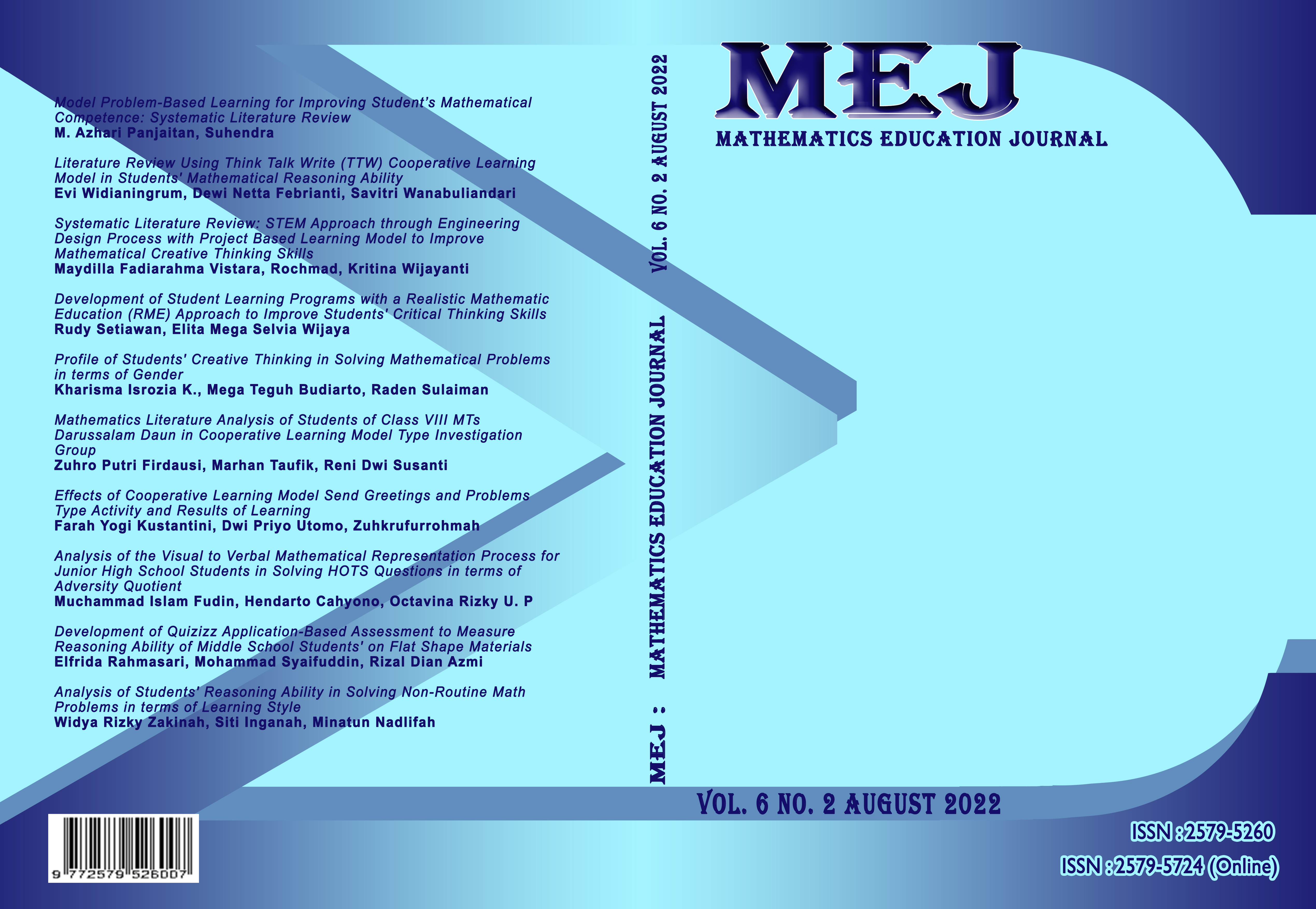Analysis of the Visual to Verbal Mathematical Representation Process for Junior High School Students in Solving HOTS Questions in terms of Adversity Quotient
DOI:
https://doi.org/10.22219/mej.v6i2.23047Abstract
Representation is a tool to solve a problem in the form of interpretation of what students think of a problem in the form of visual, verbal, and algebraic or symbolic representations. Solving non-routine problems in mathematics learning requires high order thinking skills (HOTS). Solving student problems, both routine and non-routine problems can be influenced by the ability of students to process existing problems into a challenge that must be passed, which is called Adversity Quotient. The purpose of this study was to describe the process of visual to verbal mathematical representation of junior high school students in solving HOTS questions in terms of the adversity quotient. The research uses a qualitative approach, the type of research used in this research is descriptive qualitative research. The data obtained in the form of written test results data, questionnaire results data and interview data will be submitted in written or oral form in narrative form. The instruments used are in the form of tests and questionnaires. The result show that the subject representation process with the adversity quotient level for the climber category has met the representation process indicators well in the three HOTS questions that were worked on. Subjects with the adversity quotient level in the camper category have not been able to meet the indicators of the representation process in the HOTS problem of creating.
Downloads
References
Ahmad, J., Rahmawati, D., Anwar, R., B., 2020. Proses Translasi Representasi Siswa dalam Menyelesaikan Permasalahan Matematika yang Berorientasi Pada High Order Thinking Skills. Aksioma, 9(3), 631-640
Bal, A. P. 2014. The Examination of Representations used by Classroom Teacher Candidates in Solving Mathematical Problems, Educational Sciences: Theory & Practice 14(6), 2349–2365. https://doi.org/10.12738/estp.2014.6.2189
Bal, A. P. 2015. Skills Of Using And Transform Multiple Representations Of The Prospective Teachers. Procedia - Social and Behavioral Sciences, 197(February), 582–588. https://doi.org/10.1016/j.sbspro.2015.07.197
Biber, A. Ç. (2014). Mathematics teacher candidates ’ skills of using multiple representations for division of fractions, Academic Journal 9(8), 237–244. https://doi.org/10.5897/ERR2013.1703
Bossé, M. J. 2011. Translations Among Mathematical Representations: Teacher Beliefs and Practices, (June), 1–23.
Bossé, M. J., & Lee, T. D. 2010. The NCTM Process Standards and the Five Es of Science : Connecting Math and Science, 110(5).
Bossé, M. J., Adu-Gyamf, K., Chandler, K. 2014. Students Differentiated translation processes
Hernawati F. 2016. Pengembangan Perangkat Pembelajaran Matematika dengan Pendekatan PMRI Berorientasi Pada Kemampuan Representasi Matematis. 3, 34–44
Krathwohl, D. R. 2017. A Revision of Bloom ’ s Taxonomy :, 5841(November). https://doi.org/10.1207/s15430421tip4104.
Kurniati, D., dkk., 2016. KEMAMPUAN BERPIKIR TINGKAT TINGGI SISWA SMP DI KABUPATEN JEMBER DALAM MENYELESAIKAN SOAL BERSTANDAR PISA. Jurnal Penelitian dan Evaluasi Pendidikan. 20(2) 142-155 doi: http://dx.doi.org/10.21831/pep.v20i2.8058
Murtianto, dkk. 2019. Analisis Kemampuan Representasi Verbal Siswa dalam Pemecahan Masalah Matematika Berdasarkan Tahapan Krulik dan Rudnick Ditinjau dari Motivasi Belajar Siswa. Jurnal Ilmiah Pendidikan Matematika Vol. 4(1)
NCTM. 2000. Priciples and Standars for School Mathematics. United States of America: Library of Congress Cataloguing-in-Publication Data.
Permendikbud Nomor 35 Tahun 2018. Perubahan atas Peraturan Menteri Pendidikan dan Kebudayaan Nomor 58 Tahun 2014 tentang Kurikulum 2013 Sekolah Menengah Pertama/Madrasah Tsanawiyah.
Stoltz, P. G. 2000. Adversity quotient: Mengubah hambatan menjadi peluang. Jakarta: Gramedia Widiasarana Indonesia.
Susanto, E., & Retnawati, H 2016. Perangkat Pembelajaran Matematika Bercirikan PBL Untuk Mengembangkan Hots Siswa SMA. 3(2), 189–197
Rahmawati, D., dkk. 2017. Process of Mathematical Representation Translation from Verbal into Graphic, 12(3), 367–381.
Rahmawati D., dkk. 2015. Representasi Visual Matematika Siswa dalam
Menyelesaikan Masalah Verbal spldv Kelas IX SMP. Jurnal Pendidikan dan Pembelajaran Khatulistiwa. Vol. 4(5).
Rahmawati, D. 2019. TRANSLATION BETWEEN MATHEMATICAL REPRESENTATION : HOW STUDENTS UNPACK SOURCE REPRESENTATION ?, Jurnal Matematika dan Pembelajaran. 7(1), 50–64.
Rahmawati, P. S. 2015. Pengaruh pendekatan problem solving terhadap kemampuan representasi matematis siswa.
Sa’diyah, dkk. 2020. Translasi Antar Representasi Matematis Visual Ke Verbal Dalam Memahami Konsep Pada Materi Spldv Ditinjau Dari Kemampuan Matematika Tinggi. Imajiner: Jurnal Matematika dan Pendidikan Matematika, 2(4)
Widyastuti N. 2015. Proses Berpikir Siswa dalam Menyelesaikan Masalah Matematika berdasarkan Teori Polya ditinjau dari Adversity Quotient Tipe Climber, 6(2), 183–193.
Downloads
Published
Issue
Section
License
Copyright (c) 2022 Muchammad Islam Fudin, Hendarto Cahyono, Octavina Rizky Utami Putri

This work is licensed under a Creative Commons Attribution-ShareAlike 4.0 International License.
Authors who publish with MEJ (Mathematics Education Journal) agree to the following terms:
For all articles published in MEJ, copyright is retained by the authors. Authors give permission to the publisher to announce the work with conditions. When the manuscript is accepted for publication, the authors agree to automatic transfer of the publishing right to the publisher.
Authors retain copyright and grant the journal right of first publication with the work simultaneously licensed under a Creative Commons Attribution-ShareAlike 4.0 International License that allows others to share the work with an acknowledgment of the work's authorship and initial publication in this journal.
Authors are able to enter into separate, additional contractual arrangements for the non-exclusive distribution of the journal's published version of the work (e.g., post it to an institutional repository or publish it in a book), with an acknowledgment of its initial publication in this journal.
Authors are permitted and encouraged to post their work online (e.g., in institutional repositories or on their website) prior to and during the submission process, as it can lead to productive exchanges, as well as earlier and greater citation of published work (See The Effect of Open Access).

This work is licensed under a Creative Commons Attribution-ShareAlike 4.0 International License.










